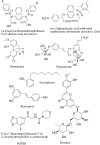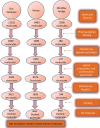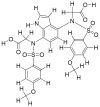In-silico based discovery of potential Keap1 inhibitors using the strategies of pharmacophore screening, molecular docking, and MD simulation studies
- PMID: 40256239
- PMCID: PMC12008509
- DOI: 10.34172/bi.30335
In-silico based discovery of potential Keap1 inhibitors using the strategies of pharmacophore screening, molecular docking, and MD simulation studies
Abstract
Introduction: The main objective of this research is to identify potential leads for developing potent Keap1 inhibitors.
Methods: In the current research article, in-silico methods have been employed to discover potential Keap1 inhibitors. 3D-QSAR was generated using the ChemBL database of Keap1 inhibitors with IC50. The best pharmacophore was selected for the screening of three different libraries namely Asinex, MiniMaybridge, and Zinc. The molecules screened from the databases were filtered through druggability rules and molecular docking studies. The best binding molecules obtained after docking studies were subjected to physicochemical properties toxicity determination by in-silico methods. The best hits were studied for stability in the cavity of Keap1 by molecular dynamic simulations.
Results: The virtual screening of different databases was carried out separately and three leads, were obtained. These lead molecules ASINEX 508, MiniMaybridgeHTS_01719, and ZINC 0000952883 showed the best binding in the Keap1 cavity. The molecular dynamic simulations of the binding complexes of the leads support the docking analysis. The leads (ASINEX 508, MiniMaybridgeHTS_01719, and ZINC 0000952883) were stabilized in the Keap1 binding cavity throughout 100 ns simulation, with average RMSD values of 0.100, 0.114, and 0.106 nm, respectively.
Conclusion: This research proposes three lead molecules as potential Keap1 inhibitors based on high throughput screening, docking, and MD simulation studies. These hit molecules can be used for further design and development of Keap1 inhibitors. This research provides the preliminary data for discovering novel Keap1 inhibitors. It opens new avenues for medicinal chemists to explore antioxidant-stimulating molecules targeting the Keap1-Nrf2 pathway.
Keywords: 3DQSAR; Docking; Keap1 inhibitors; Molecular dynamics; Oxidative stress; Virtual screening.
© 2025 The Author(s).
Conflict of interest statement
Authors declare no conflict of interest.
Figures
Similar articles
-
Pharmacophore based virtual screening for identification of effective inhibitors to combat HPV 16 E6 driven cervical cancer.Eur J Pharmacol. 2023 Oct 15;957:175961. doi: 10.1016/j.ejphar.2023.175961. Epub 2023 Aug 5. Eur J Pharmacol. 2023. PMID: 37549730
-
In Silico Drug-designing Studies on Sulforaphane Analogues: Pharmacophore Mapping, Molecular Docking and QSAR Modeling.Curr Drug Discov Technol. 2021;18(1):139-157. doi: 10.2174/1570163816666191112122047. Curr Drug Discov Technol. 2021. PMID: 31721705
-
Pharmacophore-based virtual screening, 3D QSAR, Docking, ADMET, and MD simulation studies: An in silico perspective for the identification of new potential HDAC3 inhibitors.Comput Biol Med. 2023 Nov;166:107481. doi: 10.1016/j.compbiomed.2023.107481. Epub 2023 Sep 16. Comput Biol Med. 2023. PMID: 37741229
-
Structural Investigation of Vinca Domain Tubulin Binders by Pharmacophore, Atom based QSAR, Docking and Molecular Dynamics Simulations.Comb Chem High Throughput Screen. 2017;20(8):682-695. doi: 10.2174/1386207320666170509151253. Comb Chem High Throughput Screen. 2017. PMID: 28486912
-
Identification of potential PKC inhibitors through pharmacophore designing, 3D-QSAR and molecular dynamics simulations targeting Alzheimer's disease.J Biomol Struct Dyn. 2018 Nov;36(15):4029-4044. doi: 10.1080/07391102.2017.1406824. Epub 2017 Dec 13. J Biomol Struct Dyn. 2018. PMID: 29182053
References
LinkOut - more resources
Full Text Sources
Miscellaneous
































